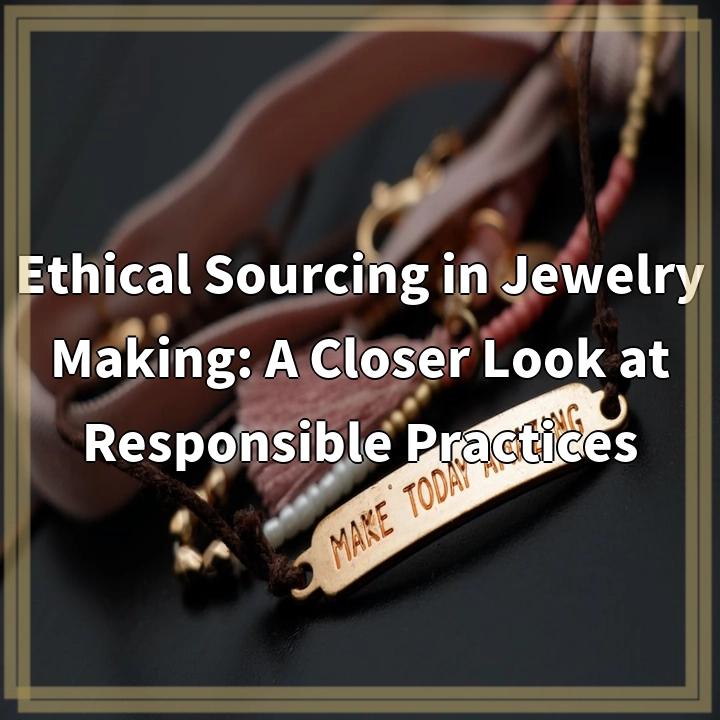
What is Ethical Sourcing in Jewelry Making?
Ethical sourcing in jewelry making refers to the practice of ensuring that the materials used in jewelry production are obtained in a responsible and sustainable manner. It involves considering the social, environmental, and economic impacts of sourcing gemstones, precious metals, and other materials used in the creation of jewelry. Ethical sourcing aims to minimize any negative effects on workers, communities, and the environment while promoting fair trade, transparency, and accountability throughout the supply chain.
Real-World Problems Associated with Ethical Sourcing
Despite the growing awareness of ethical concerns in the jewelry industry, several real-world problems persist. These issues can have significant consequences on the individuals and environments involved in the production process. Some of the key problems include:
1. Exploitation of Mining Communities
Mining for precious metals and gemstones often takes place in developing countries where labor regulations and working conditions may be substandard. In some cases, mining communities face exploitation, human rights violations, and unsafe working environments. This exploitation can perpetuate a cycle of poverty and harm to communities that rely on mining for their livelihoods.
2. Environmental Degradation
The extraction of metals and gemstones from the earth can cause significant environmental damage. Irresponsible mining practices, such as the use of harmful chemicals and the destruction of natural habitats, can lead to soil erosion, deforestation, water pollution, and loss of biodiversity. These environmental impacts can have long-lasting effects on ecosystems and local communities.
3. Lack of Transparency and Traceability
One of the challenges in ensuring ethical sourcing is the lack of transparency and traceability within the jewelry supply chain. It can be difficult for consumers to determine the origin of the materials used in jewelry, making it hard to assess the social and environmental impacts associated with their purchase. This lack of transparency also makes it easier for unethical practices, such as the use of conflict minerals, to go undetected.
4. Counterfeit and Misleading Claims
Another problem in the jewelry industry is the prevalence of counterfeit or mislabeled products. Some jewelry may be marketed as ethically sourced when, in reality, it does not meet the required standards. This makes it challenging for consumers to make informed choices and support genuinely responsible practices.
In conclusion,
Ethical sourcing in jewelry making is a crucial aspect of promoting responsible practices within the industry. By addressing these real-world problems associated with ethical sourcing, we can strive towards a more sustainable and socially conscious jewelry market that respects both the people and the planet.

Solutions to the Problems of Ethical Sourcing in Jewelry Making
Addressing the real-world problems associated with ethical sourcing in jewelry making requires a proactive approach from all stakeholders involved. Here are some potential solutions to consider:
1. Establishing Fair Trade Standards
Implementing fair trade standards can help ensure that workers involved in jewelry production are treated fairly and paid a living wage. Certification programs, such as Fairtrade Gold, provide guidelines that promote responsible mining practices and support mining communities.
2. Supporting Artisanal and Small-Scale Mining
Encouraging the support and development of artisanal and small-scale mining (ASM) can help create a more sustainable and inclusive jewelry supply chain. By providing training, access to markets, and improved working conditions, ASM can be a viable and ethical alternative to large-scale industrial mining.
3. Implementing Transparent Supply Chains
Establishing transparent supply chains enables consumers to trace the journey of raw materials used in jewelry making. Blockchain technology, for example, can enhance traceability, allowing buyers to verify the provenance and ethical sourcing of materials.
4. Enforcing Regulation and Monitoring
Governments and regulatory bodies should enforce and strengthen regulations to ensure that ethical standards are met throughout the jewelry industry. Regular monitoring and inspections can help identify and prevent unethical practices, especially in countries where mining regulations may be lax.
5. Increased Consumer Awareness and Demand
Educating consumers about the importance of ethical sourcing in the jewelry industry can create a demand for responsibly produced jewelry. Supporting brands and jewelers committed to ethical practices can encourage the industry at large to adopt responsible sourcing as the norm.
In conclusion,
By implementing these solutions, stakeholders in the jewelry industry can work towards a more ethical and sustainable future. Ensuring fair treatment of workers, protecting the environment, promoting transparency, and fostering consumer awareness will contribute to a responsible and socially conscious jewelry sector.















